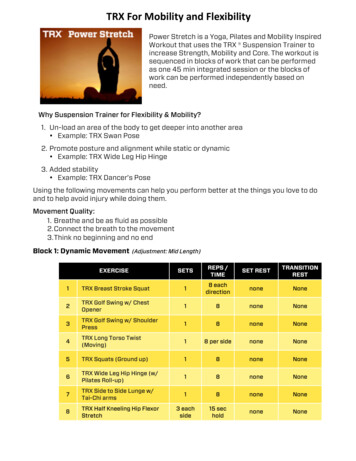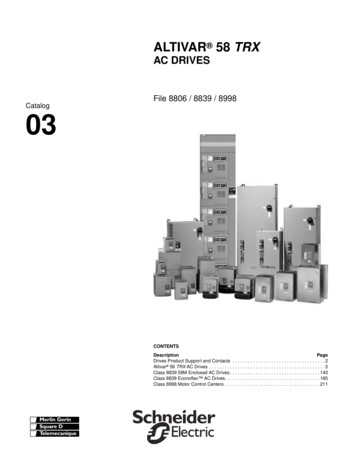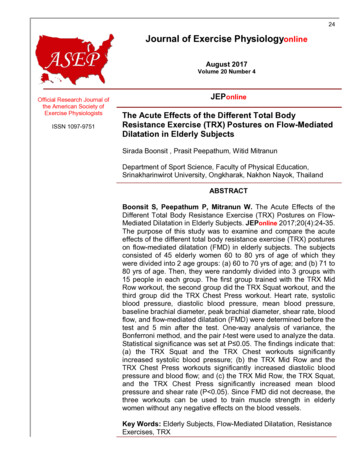
Transcription
trx : Regular-tree expressions, now in SchemeIlya BagrakUniversity of California, Berkeleyibagrak@eecs.berkeley.eduOlin ShiversCollege of ComputingGeorgia Institute of Technologyshivers@cc.gatech.eduAbstractoperate upon and produce results in this form can therefore easilybe connected together to construct larger computations, providingfor a large degree of code reuse. In the world of Scheme programming, s-expressions are the universal interchange format.Regular-tree expressions are to semi-structured data, such as XMLand Lisp s-expressions, what standard regular expressions are tostrings: a powerful “chainsaw” for describing, searching and transforming structure in large data sets. We have designed and implemented a little language, trx, for defining regular-tree patterns. Wediscuss the design of trx, its underlying mathematical formalisationwith various kinds of tree automata, and its implementation technology. One of the attractions of trx is that, rather than being acomplete, ad hoc language for computing with trees, it is insteadembedded within Scheme by means of the Scheme macro system.The features of the design are demonstrated with multiple motivating examples. The resulting system is of general use to programmers who wish to operate on tree-structured data in Scheme.1The charm of s-expressions as an LCD representation is that, unlike strings, they come with some degree of existing structure. Thiseliminates much of the parsing/unparsing overhead that is typicallyrequired when computational agents interact using string intermediate representations (parsing that, in the Unix-tools setting, is frequently done by means of heuristic, incomplete, error-prone handwritten parsers). Another Perlis aphorism makes clear the downsides of using strings as an LCD form: “The string is a stark datastructure and everywhere it is passed there is much duplication ofprocess. It is a perfect vehicle for hiding information.” The problem with strings as a least-common denominator is that they are too“least,” that is, too low level. We operate upon strings a character ata time—a level where it is all too easy to break the invariants of theassociated grammar that typically imposes structure and meaningon the strings.LCD data representationsSemi-structured and tree-structured data has become an importanttopic in the world of software engineering in the past few years, dueto the widespread adoption of XML as a generic representation format for data. While this may be news to rest of the world, it is a veryfamiliar picture to programmers in the Lisp family of languages.The Scheme and Lisp community has long been aware of the benefits of fixing on a general-purpose data structure for representingtrees, and specifying a standard concrete character representationfor these trees. Lisp s-expressions are essentially XML trees; theLisp community has worked within the s-expression framework forrepresenting data since the inception of the language in the 1960’s.Even when s-expressions may not be the appropriate representationfor the core data structures of an application, they still frequentlyfind use around the application’s “fringe,” being converted to andfrom the internal, more highly-engineered core structures as theymove across the application’s boundary—with the associated benefit that it is much simpler and more robust to parse a tree than astring.2Part of the power of the Lisp family of languages comes from thisfocus on s-expressions as the central data structure of the language.A Perlis aphorism [16] captures the benefit well: “It is better to have100 functions operate on one data structure than 10 functions on 10data structures.” S-expressions are the “least common denominator” (LCD) representation for data in the Lisp family of programming languages, in the same sense that strings are the LCD representation in the world of Unix tools: the multitude of functions thatRegular trees, little languages and SchemeGiven that Lisp and Scheme programmers have been working with“semi-structured” tree data roughly three and half decades longerthan XML has even existed, it is surprising that this communityhas never bothered to adopt one of the great, expressive tools formanipulating such data: regular trees and their associated patterns.Just as traditional regular expressions are an expressive tool for describing structure occurring within strings, regular trees can serve asimilar role when dealing with recursively defined patterns occurring within trees—trees such as ones we frequently represent usingScheme s-expressions.We have long grumbled about the lack of such tools. Each timewe write a low-level Scheme macro, for example, and we find ourselves writing an incomplete and awkward syntax-checker/parserfor our new form directly in Scheme (Is the form exactly four elements long? Is the second element a list of identifier/expressionpairs? Etc.), we pause to wish for a better way. When the XMLworld began wisely to exploit the extensive theoretical machineryPermission to make digital or hard copies, to republish, to post on servers or to redistribute to lists all or part of this work is granted without fee provided that copies arenot made or distributed for profit or commercial advantage and that copies bear thisnotice and the full citation on the first page. To otherwise copy or redistribute requiresprior specific permission.Fifth Workshop on Scheme and Functional Programming. September 22, 2004, Snowbird, Utah, USA. Copyright 2004 Ilya Bagrak and Olin Shivers.21
is a set of final states, and is a set of transition rules of the form:developed to describe regular trees and their recognisers, we werefinally pushed to carry out the design and implementation exercisewe had put off so long.f (q1 , . . . , qn ) q,where n 0, f Fn , and q, q1 , . . . , qn Q. The symbols q1 , . . . , qnand q are called the initial and final states of the transition, respectively.The result is trx, a language for describing regular-tree patterns.Embedding our “little language” within Scheme provides for several benefits, which we’ve described elsewhere in detail [17]. Onone hand, it made our task as designers and implementors easier.We only needed to design and implement tree patterns; we didn’tneed to implement the machinery already provided by Scheme:floating-point numbers, first-class functions, variables, loops, etc.On the other hand, for our programmer clients, the result was a toolthat allowed regular-tree pattern matching to be tightly integratedwith Scheme programs, instead of forcing this kind of operationout into a separate, distinct program written in some distinct, adhoc, self-contained domain-specific language.The operation of a tree automaton involves propagating state information up (or down) through the tree. Transition rules determinehow this propagation takes place. Whenever a label f is seen at atree node and that label has the states q1 , . . . , qn “bubbled-up” to itschildren, and a rule f (q1 , . . . , qn ) q exists in , state q is propagated to the f -labelled node. In turn, the bubbled-up state thenfeeds into its parent node. The propagation continues until somestate is bubbled up to the root node of the tree. If this state is in Q f ,then the tree term is accepted. If no final state bubbles up to the top,the tree is rejected.The rest of this paper traces out the following arc. First, we willsurvey the basic elements of tree automata, the underlying mathematical formalism that connects the static, declarative world ofregular-tree patterns to the computational or algorithmic paradigmof their recognisers. Then we will consider the particular needsof tree pattern matching that arise when working in the setting ofScheme s-expressions. This exploration of design requirements anddesign rationale, plus the useful constraints imposed by the computational power of tree automata, allow us to proceed to a designfor regular-tree patterns that integrates with Scheme s-expressions.The syntax and semantics of trx are provided in the next section,followed by examples of trx patterns in use. Then we will examinesome details the current implementation, before concluding with adescription of related and future work.3In addition to the type of transition rule described above, traditional tree automata allow for ε-move transitions q q0 , that occur spontaneously, changing the state assigned to a node from q toq0 . Equivalence of tree automata with and without ε rules is a wellestablished result [6]; establishing the equivalence involves working with the ε-closure of states, i.e., the set of states reachable froma state via ε-rules.Fundamentally, every tree automaton A is a machine correspondingto some tree language. The tree language L (A ) recognized by A isthe set of all trees accepted by A .We’ve described the operation of an FTA in a bottom-up manner,but it can also be operated in a top-down manner, starting with anaccept state for the root, and running the transition rules “backwards” to find the labels assigned to children, etc.Overview of tree automataEvery interesting programming language is just a cover for an interesting model of computation: regular expressions and finite automata; context-free grammars and push-down automata; SQL andthe relational calculus; Smalltalk and message-passing; APL andSIMD array processing; and, of course, Scheme and the λ calculus.The interesting formal model of computation underlying the designof trx is finite tree automata. The short overview that follows willspell out some of the fundamental concepts of these formal machines.3.2 Simplified tree automataA simplified finite tree automaton (SFTA) over an unranked alphabet F is a tuple As (Q , F , Qi , ), where Q is a set of states,Qi Q is a set of initial states, and is a set of transition rules.Transition rules can be either be labelled or empty:f (qin ),qout q or () q.In order to understand the way a simplified tree automaton computes, we must change our mental model of how individual nodesare “wired” together in the tree. Each node now includes a reference to its closest sibling to the right, and its leftmost child (ifany, in both cases). This setup implies that at any given point inan automaton’s operation, state-directed control can flow along twopathways—down to children and right to siblings. This is in contrast to traditional tree automata where state information is propagated to/from all children simultaneously.In the following sections we differentiate between traditional treeautomata and simplified tree automata. This paper uses the “simplified” and “traditional” qualifiers for differentiation only; they arenot part of the established nomenclature. Elsewhere in the literature, both classes of automata are referred to as tree automata interchangeably.3.1 Traditional tree automataA simplified automaton begins at the root of the tree, nondeterministically selecting a start state from Qi . If the automaton is visiting an f -labelled node n while in state q, the machine selects anf (qin ), qout q transition. (If there is no such transition, the machine halts, reporting failure.) If n has children, the machine attempts to recursively accept them, starting in state qin with n’s leftmost child; if this succeeds, it then proceeds to n’s siblings. If n isa leaf node, the machine checks for an empty transition () qout ,then proceeds to n’s siblings. If the children-match attempt fails,or there is no empty rule handling the leaf node, the machine halts,reporting failure.Tree automata operate on labelled, finite trees: trees where everynode is assigned a label f drawn from some alphabet F . Traditionalautomata also require the label alphabet to be ranked, that is, eachlabel has an associated natural number. Each tree node must haveexactly as many children as the rank assigned its label; thus, leafnodes are marked with rank-zero labels. We write Fn for the set ofrank-n labels in alphabet F .A traditional finite tree automaton (FTA) over a ranked alphabetF is a tuple A (Q , F , Q f , ), where Q is a set of states, Q f Q22
Figure 1Nondeterministic simplified finite tree automatonof generating a fresh “out” state as we did for the rules starting inq, the rules starting in qn are processed recursively with their “out”state as their right sibling’s final state qn 1 . The “out” state for therightmost sibling is the newly-generated q00 .matchnode(n,q) {f : n.labelA simplified tree automaton resulting from the conversion recognizes the same language as its traditional equivalent. However, thearity information is now encoded directly in the rules; symbols nolonger have an intrinsic arity attached to them./* Fail if no rule selectable. */Select f (qin ),qout q from if n is leafthen matchempty(qin )else matchnode(n.leftchild, qin )A conversion of a simplified tree automaton to an equivalent traditional tree automaton is not possible in the general case: as we’veseen, traditional tree automata cannot handle symbols with unbounded arity, and thus are strictly less powerful.if n has closest right sibling sthen matchnode(s,qout )else matchempty(qout )}3.4 Nondeterminism in tree automatamatchempty(q) {if () q then returnelse fail}Both of the above definitions describe non-deterministic automata,i.e., automata that can “fork” in a number of directions if multipletransitions can be applied in a given machine configuration. As withregular-string languages, a deterministic variant of tree automatacan be defined as a subset of the general nondeterministic one.To proceed to n’s siblings, the machine jumps to n’s closest rightsibling and changes state to qout . If n has no right sibling, the machine accepts iff there is an empty transition qout (). Thus emptytransition rules are needed to terminate an automaton’s recursivedescent over a tree. Pseudocode for an SFTA is shown in figure 1.The equivalence of deterministic and non-deterministic automatahas been established for traditional tree automata [6]. A traditionaltree automaton is said to be deterministic (DFTA) if there are norules with the same left-hand side, and no ε-rules.As a trivial example, consider a regular-tree language consisting ofa single term: a root node labelled with a and three child nodeslabelled with b, c, d. A simplified tree automaton for recognizingsuch a language would have transitionsThe construction of an equivalent automaton proceeds as follows.Let A (Q , F , Q f , ) be a non-deterministic tree automaton. Thenthere is an equivalent DFTA, Ad (Qd , F , Qd f , d ) such that (1)every state in Qd is a non-empty set of original states in Q , and (2)every rule in d is computed witha(q1 ),q2 q0c(q2 ),q6 q4() q2b(q2 ),q4 q1d(q2 ), q2 q6f (s1 , . . . , sn ) s0 d iffs {q q1 s1 , . . . , qn sn , f (q1 , . . . , qn ) q }s0 ε-closure(s)with Qi {q0 }.Note that the label alphabet F is unranked in the sense that when anode labelled f is processed, the automaton is only concerned withthe presence of the node’s leftmost child and closest right sibling.Nothing in the rule format enforces how many children or siblingsa given node is allowed to have. A simplified automaton can fixthe number of children permitted a tree node by encoding this inthe states traversed as it scans across the siblings, but it may alsopermit a child to have an arbitrary number of children, a degreeof power not available with traditional automata. Thus simplifiedautomata are strictly more powerful than traditional automata. Thispower is useful for the kinds of s-expression and XML trees weprocess in the real world.Just as with regular-string expressions and their associated finitestate automata, this power-set construction of an equivalent deterministic tree automaton may, in the worst case, result in exponentialstate explosion [6]. And just as with regular-string expressions, thisnegative effect is offset by the fact that deterministic tree automataare considerably faster at parsing certain regular-tree languages [6],in the standard space vs. search trade-off.We are not aware of any results pertaining to equivalence of deterministic and non-deterministic simplified tree automata. Our SFTAtechnology works strictly with non-deterministic machines—thatis, it manages non-determinacy at run time by performing backtracking search.3.3 Converting between modelsA traditional tree automaton can be converted to an equivalent simplified tree automaton in the following way. Starting from eachstate q of the initial states, the algorithm selects all the rules thathave q as their final state. For each rule f (q1 , . . . , qn ) q, a labelled rule f (q1 ), q0 q and an empty rule () q0 are added tothe simplified automaton, for fresh state q0 . Then a new state q00and empty rule () q00 are added to the automaton, for fresh stateq00 . The children states are processed similarly, except that instead4S-expressions, XML, and regular treesLisp s-expressions are frequently used to represent labelled trees,using the encoding that an internal tree node is represented by alist whose head is its label and whose tail is the list of its children;leaf nodes are simply represented by non-list data. The followingschematics illustrate the mapping:23
4.3 Factoring pattern, automaton and dataexpt(expt i j) (if a (cons a nil) b) One theme in the design of trx is factoring the layers of the design. Whether the terms under consideration are s-expressions,XML documents, or some other form of tree data, the basic pattern notation and the underlying abstract automata models, whichspecify the basic processing engine for tree terms, should remainunaltered. We’ll return to this factoring in the discussion of theimplementation.i jifa cons ba nil(set! a ( 1 2)) Another design concern was abstracting over the nuts and boltsof finite-tree automata or other possible semantic engines for trx.(E.g., is a pattern implemented as a non-deterministic traditionalFTA using search, as a deterministic traditional FTA without backtracking, or with an SFTA?) Where possible, we kept the notationand its semantics independent of these implementation pragmatics(adding variable-arity patterns in the pattern notation does restrictthe space of possible implementations, however, so this is not 100%possible).set!a 1 2In the domain of XML, the delimiting characters ( and ) are replaced with tag attr-list and /tag , with tag serving as thenode’s label. This treatment slightly oversimplifies the way XMLdocuments are put together, but it exposes the features commonto labelled-tree languages at large, which is what the trx languageis intended to process. The XML community has developed aplethora of language tools for describing regular-tree patterns aswell as transducers operating on the trees matched by these patterns [12, 4, 6, 21, 3]. Although these tools are outside the scope ofthis paper, their existence reaffirms the utility of convenient, robusttools for regular-tree processing.4.4 Escapes to SchemeWe’ve found it useful in previous little-language designs to provide mechanisms not only for embedding the little language withinScheme, but for embedding general Scheme within the little language. This, of course, dramatically changes the power of the pattern model, allowing us to define pattern matchers whose top-levelcontrol skeleton is an FTA, but who may invoke arbitrary computation at the “leaves” of the computation. Adding such a facilityhas an impact on the implementation of the system, restricting ourability to statically analyse patterns (a price we pay for the increasedcomputational power), and requiring the implementation to be written so it can simply pass the embedded Scheme code through thepattern compiler, to be dropped into place in the final output.4.1 Variable-arity constructorsOne issue that arises when considering tree structure in XML andsymbol-labelled s-expression trees is the possibility of variablearity constructors (that is, variable-rank tree labels). Both ( 37) and ( 2 6 3 1) are legal Scheme expressions, yet the label must be assigned a fixed arity in order for a traditional treeautomata to be able to match it. These cases arise in both XML ands-expression trees, and when they do, we must resort to the morepowerful model of simplified tree automata.As we’ll see, the ability to invoke arbitrary Scheme at the leaves ofthe pattern matcher in particular allow us to have trees whose leafnodes are not just symbols, but any kind of data. This is importantin the world of Scheme s-expressions, which are frequently composed of more than symbols and parentheses—they may, for example, contain records or booleans or strings. We might, in some contexts, wish to permit only leaves that are positive integers between0 and 100—something which does not fit the basic tree-automatamodel, which discriminates only on the symbols that label nodes,including leaf nodes.4.2 Unlabelled tree nodesAnother issue we find in the context of interpreting s-expressionsas labelled trees is that in some s-expressions, not all tree nodesare labelled. For example, consider the structure of a Scheme letform, which has the following syntax:Similarly, when a user writes down a regular-tree expression to describe the syntax of the Scheme let form, he will want to capturein the pattern the fact that the left-hand sides of the binding formscan be any symbol at all. . . but only a symbol, not a general subtree.1 Allowing escapes to general Scheme code permits us to write(let ((var exp) .) body .)1 If he wants to capture the constraint that these bound identifiers must be distinct from one another, he’s completely outside thepower of the regular-tree model. The price we pay for specialisednotations and restricted computational models is that we can’t solveall possible problems. Note that our hypothetical programmer couldalways use a more complex escape to Scheme to check this distinctidentifier constraint, or defer it to a later check. This is analogousto the way compilers detect some illegal programs while parsing(i.e., syntax errors), leaving others for later static analysis to find(e.g., type errors). This distinction happens for the same reason—the expressiveness of context-free grammars and the power of theassociated push-down automata that recognise their languages arerestricted, making them unable to encode all the static constraintsThe first child of a let node, the bindings list ((var exp) .),has no label. (As we discussed above, it is also variable-arity.) Wecan find the same problem in the syntax of the individual clauses ofa cond expression, or even in the “default” syntax of Scheme function calls, which are not introduced by any kind of call keyword.It is not technically difficult to handle unlabelled nodes within thefinite-automaton model; our implementation does so by introducingspecial anonymous symbols that have unique names with respect tothe rest of the automaton’s label set. The critical point is that, tohandle this tree idiom, which occurs in common practice with sexpressions, we must account for them in the design of our patternnotation.24
such patterns, yet remain in the tree-automaton/declarative-patternmodel for the most part. This functionality is conceptually alignedwith the Scheme’s own type system where types are typically defined by means of general Scheme predicates which discriminatebetween members and non-members of the type, e.g., functionssuch as list?, string?, symbol?, and so forth.What makes regular-tree patterns interesting is recursion in the patterns. This is introduced with the rec and letrec forms. Thepattern (rec ident rte) matches a tree that matches rte, with theproviso that free references to ident in rte must recursively matchthe pattern, as well. Thus we can describe a pattern that matchesbinary trees whose internal nodes are labelled and whose leavesare 42 with the pattern4.5 Dynamic patterns(rec t ( 42 (@ t t)))Besides inlining Scheme predicates to match tree leaves, we mightalso want to escape to Scheme code within a pattern in order tocompute a sub-pattern. This allows users to dynamically stitch treeautomata together, or construct patterns which may have a run-timedependency on particular computations or input data.This would match any of the trees 42, ( 42 42), ( 42 ( 4242)), ( ( 42 42) 42) and so forth.The letrec form allows mutual recursion by binding the patternidentifiers in a recursive scope. We can also bind pattern identifierswith simple lexical scope with the let form.4.6 Collecting submatch dataThe (submatch rte) form lets us mark a part of a larger patternto indicate to the pattern matcher that, in the event of a completematch, the sub-trees matching rte should be retained for later retrieval. Note that a single submatch can match more than a singletree term. For instance, the patternsWe frequently want our patterns to do more than simply recognisetrees, reporting only a “yes” or a “no.” In many cases, we want touse our patterns to select indicated parts of a tree. One mechanismfor doing so is to add elements to the pattern language for marking components of a tree that match particular pieces of a pattern.On a successful match, the selected sub-trees are then returned tothe programmer as a result. String regular expressions frequentlyhave similar kinds of support for picking out elements of a matchedstring. Providing submatches in the pattern notation complicatesthe implementation of the pattern matcher; in particular, the patternoptimiser has to be careful not to optimize away subpatterns thatcontain a submatch.5(rec t ( 42 (@ (submatch t) t)))(@ (* (submatch 42)))would produce, upon a successful match, a variable number of submatches depending on the height and width of the tree term. Thematcher produces a list of terms for any single submatch form, ordered according to the pre-order position of submatched terms inthe original tree. Thus for pattern(rec t ( ,number? (submatch (@ t t))))The trx languageand tree term ( ( 1 2) ( 3 4)), the list of saved items forthe submatch will consist of every internal node in the source tree:The syntax of trx patterns takes the form of the familiar s-expressionand borrows extensively from the SRE regular-expression notationintroduced in scsh [19, 18]. The grammar is given in figure 2.(( ( 1 2) ( 3 4))( 1 2)( 3 4))A regular-tree expression (or pattern) denotes a set of trees. A pattern which is simply a literal, such as the number 5, is a patternmatching only the leaf tree 5. Similarly, the pattern ’fred (or,equivalently, (quote fred)) matches the leaf which is the symbol fred.Finally, we can escape to general Scheme code in two differentways. The pattern ,exp allows us to write a Scheme expressionproviding a general predicate which accepts or rejects trees. Thuswe can change our sum-of-42s example above to be a sum tree forgeneral numbers with the patternThe pattern (@ symbol rte .) matches a tree whose root is labelled with symbol, and whose children match the rte sub-patterns.When symbol doesn’t conflict with one of the pattern keywords, the@ can be elided. A tree with an unlabelled root can be matched witha ( rte .) pattern.(rec t ( ,number? (@ t t)))or a sum tree of even numbers with the patternWe introduce choice with the pattern ( rte .) which matchesany tree matched by any of the rte subforms.(rec t ( ,(λ (x) (and (number? x)(even? x)))(@ t t)))The pattern (any) matches any tree. We can write a match whichmatches no tree with the empty-choice pattern ( ). This is notparticularly useful for user-written patterns, but could be useful forpatterns produced mechanically, either from higher-level macros ordynamically in response to program input.The pattern ,@scheme-exp, allows us to write a Scheme expressionthat itself evaluates to a trx pattern value, which is then plugged intothe enclosing pattern. This allows us to dynamically construct trxpatterns, instead of restricting them to patterns that are completelyfixed at compile time. (Consequently, this feature has major implications on the compile-time handling of patterns—when it is used,we must do a kind of “partial evaluation” of the pattern, deferringthe processing of dynamic components to run time. Fortunately, wecan statically determine if a particular pattern uses this feature ofthe language, and so only need defer such processing with patternsthat do so. So the extra overhead of dynamic pattern construction isonly invoked as needed, making it a pay-as-you-go feature.)The sequence operators *, and ? match zero-or-more, one-ormore and zero-or-one trees matching their subpattern, respectively.of a well-formed legal program. The role of a little language is tomake the common cases easy; the role of a general purpose language (such as our escapes to Scheme) is to make the rest of thecases possible.25
Figure 2 Syntax of trx regular-tree expressions.rte :: literal ’symbol (@ symbol rte .) (symbol rte .) ( rte .) (any) ( rte .) (* rte) ( rte) (? rte) (rec ident rte) (let ((ident rte) .) rte) (let* ((ident rte) .) rte) (letrec ((ident rte) .) rte) ident (submatch rte) ,scheme-exp ,@scheme-exp;Literal atom;Tree with root labelled symbol;As for @, when no ambiguity.;Tree with unlabelled root;Matches any tree;Choice;Matches a sequence of [0, ) rte’s;Matches a sequence of [1, ) rte’s;Matches a sequence of [0, 1] rte’s;Recursively defined pattern;Lexical pattern binding;Lexical pattern binding;Pattern with mutual recursion;Reference to pattern bound by rec, let or letrec;Matched subtree saved for subsequent retrieval;General predicate;Dynamically computed tree automatonident :: symbolliteral :: number string boolean char7As an example putting multiple components of the language together, a pattern which specifies the syntax of the Scheme let expression isAt last, we present a set of examples which work
invokedas(trx-match pat s-exp),takingatreeautomatonpat (producedbya(trx rte )form),andatree s-exp towhichitshould










